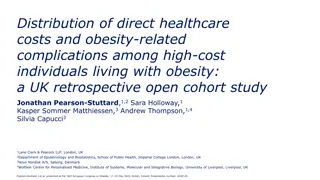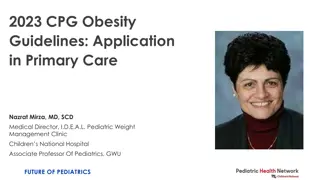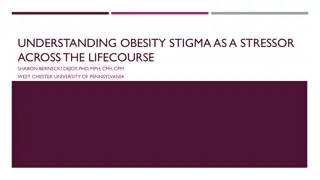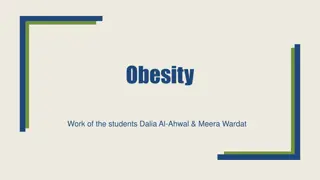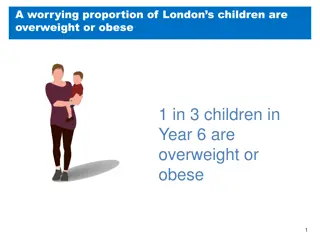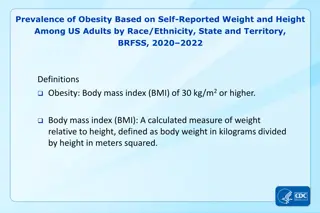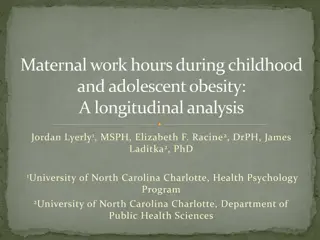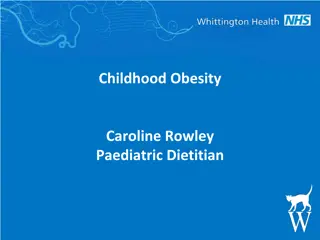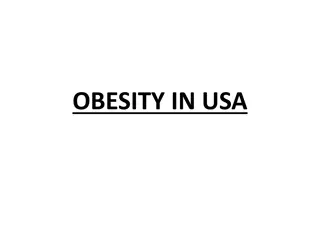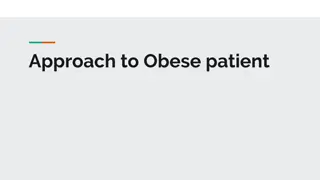
Understanding Overweight and Obesity: Definition, Epidemiology, Etiology, Classification, and Diagnostics
Explore the concepts of overweight and obesity, covering their definitions, prevalence, causes, classification, and diagnostic criteria. Learn about the factors contributing to weight gain, including medical conditions, dietary factors, and genetic influences. Discover the importance of behavioral intervention, health improvement goals, and the assessment of risk factors associated with obesity-related comorbidities.
Download Presentation

Please find below an Image/Link to download the presentation.
The content on the website is provided AS IS for your information and personal use only. It may not be sold, licensed, or shared on other websites without obtaining consent from the author. If you encounter any issues during the download, it is possible that the publisher has removed the file from their server.
You are allowed to download the files provided on this website for personal or commercial use, subject to the condition that they are used lawfully. All files are the property of their respective owners.
The content on the website is provided AS IS for your information and personal use only. It may not be sold, licensed, or shared on other websites without obtaining consent from the author.
E N D
Presentation Transcript
OVERWEIGHT AND OBESITY . DEFINITION. EPIDEMIOLOGY . ETIOLOGY . CLASSIFICATION . DIAGNOSTICS .
OVERWEIGHT AND OBESITY " CONDUCTING OBESITY IS USED TO DESCRIBE IMPROVEMENTS RELATED WITH HEALTH , AND NOT ONLY RESULTS LOSSES MASSES BODY (MT). IF BECAUSE OF INTERVENTION OBSERVED WEIGHT LOSS , IT SHOULD NOT BE THE ONLY GOAL THAT DOES NOT COUNT IMPROVEMENT OF HEALTH AND QUALITY OF LIFE. OVERWEIGHT DETERMINED IN THE CASE OF BMI FROM 25 TO 29.9 KG/M2. IS THE NEED FOR ISOLATION OF THIS STATE, SINCE HE PRECEDES DEVELOPMENT OBESITY AND NEEDS MEDICINAL INTERVENTION BEHAVIORAL THERAPY IS INTERVENTION OF CHANGES BEHAVIOR WITH THE HELP OF PROGRAMS WHICH HELP PATIENTS ACHIEVE THEIR OWN BEHAVIORAL GOALS IN THE INDUSTRY HEALTH ( NUTRITION , PHYSICAL ACTIVITY , SLEEP, DECREASE STRESS ETC. ) OR PROTECTION HEALTH ( FOR EXAMPLE , IMPROVEMENT OF QUALITY OF LIFE, TREATMENT OBESITY ).
ETIOLOGY . Drugs that cause weight gain Drugs that cause weight gain Hypothalamic surgery Hypothalamic surgery Dietary obesity Dietary obesity Rules for feeding babies Rules for feeding babies Progressive hyperplastic obesity Progressive hyperplastic obesity Meal frequency Meal frequency High fat diets High fat diets Overeating Overeating Neuroendocrine obesity Neuroendocrine obesity Hypothalamic obesity Hypothalamic obesity Hypothyroidism Hypothyroidism Seasonal affective disorder Seasonal affective disorder Cushing's syndrome Cushing's syndrome Polycystic ovary syndrome Polycystic ovary syndrome Hypogonadism Hypogonadism Growth hormone deficiency Growth hormone deficiency Pseudohypoparathyroidism Pseudohypoparathyroidism
DIAGNOSTICS NECESSARILY RATE : ALL AVAILABLE SYMPTOMS ; ALL UNDERLYING CAUSES - OVERWEIGHT OR OBESITY ; FOOD HABITS ; THE PRESENCE OF ANY COMORBIDITIES ( FOR EXAMPLE , TYPE 2 DIABETES, HYPERTENSION, CVD, OSTEOARTHRITIS, DYSLIPIDEMIA , AND APNEA IN DREAMS );
DIAGNOSTICS THE PRESENCE OF ANY FACTORS RISK IDENTIFIED DURING THE ASSESSMENT LIPID PROFILE ( PREFERABLY DEFINED FASTING ), BLOOD PRESSURE MEASUREMENT AND DETERMINATION HBA1C; METHOD LIFE ( FOOD AND PHYSICAL ACTIVITY ); ALL PSYCHOSOCIAL STRESS ; ALL FACTORS FROM THE ENVIRONMENT , SOCIETY AND FAMILY , INCLUDING FAMILY ANAMNESIS NADMT OR OBESITY AND COMORBIDITIES BECAME


